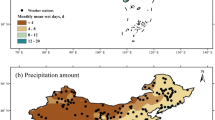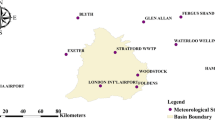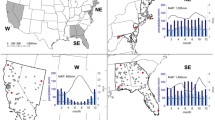Abstract
Spatial autocorrelation is a correlation between the values of a single variable, considering their geographical locations. This concept has successfully been used for multi-site generation of daily precipitation data (Khalili et al. in J Hydrometeorol 8(3):396–412, 2007). This paper presents an extension of this approach. It aims firstly to obtain an accurate reproduction of the spatial intermittence property in synthetic precipitation amounts, and then to extend the multi-site approach to the generation of daily maximum temperature, minimum temperature and solar radiation data. Monthly spatial exponential functions have been developed for each weather station according to the spatial dependence of the occurrence processes over the watershed, in order to fulfill the spatial intermittence condition in the synthetic time series of precipitation amounts. As was the case for the precipitation processes, the multi-site generation of daily maximum temperature, minimum temperature and solar radiation data is realized using spatially autocorrelated random numbers. These random numbers are incorporated into the weakly stationary generating process, as with the Richardson weather generator, and with no modifications made. Suitable spatial autocorrelations of random numbers allow the reproduction of the observed daily spatial autocorrelations and monthly interstation correlations. The Peribonca River Basin watershed is used to test the performance of the proposed approaches. Results indicate that the spatial exponential functions succeeded in reproducing an accurate spatial intermittence in the synthetic precipitation amounts. The multi-site generation approach was successfully applied for the weather data, which were adequately generated, while maintaining efficient daily spatial autocorrelations and monthly interstation correlations.












Similar content being viewed by others
Abbreviations
- A :
-
matrix (3,3) whose elements are defined from lag 0 and lag 1 serial and cross-correlation coefficient matrices of observed residuals
- B :
-
matrix (3,3) whose elements are defined from lag 0 and lag 1 serial and cross correlation coefficient matrices of observed residuals
- F :
-
spatial exponential cumulative distribution function
- I :
-
Moran value
- l :
-
total number of days in a given month
- m :
-
total number of γ Tmax, γ Tmin or γ Sr values taken from their range
- M 0 :
-
matrix of lag 0 serial and cross-correlations
- M 1 :
-
matrix of lag 1 serial and cross-correlations
- n :
-
total number of locations
- r t (k):
-
synthetic precipitation amount at site k on day t
- SDI:
-
spatial dependence indicator
- u Tmax (n, 1):
-
vector of n independent and normally distributed random numbers used for maximum temperature
- u Tmin (n,1):
-
vector of n independent and normally distributed random numbers used for minimum temperature
- u Sr (n,1):
-
vector of n independent and normally distributed random numbers used for solar radiation
- v t (k):
-
uniform [0, 1] random number
- V Tmax(n, 1):
-
vector of n spatially autocorrelated random numbers used for maximum temperature
- V Tmin(n,1):
-
vector of n spatially autocorrelated random numbers used for mimimum temperature
- V Sr(n,1):
-
vector of n spatially autocorrelated random numbers used for solar radiation
- w ij :
-
spatial weight between two locations i and j
- W(n,n):
-
weight matrix
- w max :
-
maximum positive eigenvalue of W(n, n)
- w min :
-
largest negative eigenvalue of W(n, n) in absolute value
- X :
-
single variable
- x i :
-
observed value at location i
- \( \bar{x} \) :
-
average of the x i over n locations
- \( \bar{X}_{k} \left( j \right) \) :
-
mean of temperature or solar radiation
- χ p,k (j):
-
matrix (3,1) of maximum temperature (j = 1), minimum temperature (j = 2) and solar radiation (j = 3) residuals for day k of year p
- λ t (k):
-
inverse of the precipitation mean at site k on day t
- σ k (j):
-
standard deviation of temperature or solar radiation
- ɛ p,k (j):
-
matrix (3, 1) of independent standard normal random numbers N[0,1] for day k of year p
- \( \rho_{{{{\upchi}}_{i,0\;} {{\upchi}}_{j,0} }} \) :
-
lag 0 cross-correlation coefficient between the residuals of variable i and the residuals of variable j
- \( \rho_{{{{\upchi}}_{i,0\;} {{\upchi}}_{j, - 1} }} \) :
-
lag 1 cross-correlation coefficient between the current residuals of variable i and the previous residuals of variable j
- \( \rho_{{{{\upchi}}_{i,0\;} {{\upchi}}_{i, - 1} }} \) :
-
lag 1 serial correlation of variable i
- γ Tmax :
-
moving average coefficient used for maximum temperature
- γ Tmin :
-
moving average coefficient used for minimum temperature
- γ Sr :
-
moving average coefficient used for solar radiation
References
Anselin L (1980) Estimation methods for spatial autoregressive structures, No. 8. Regional science dissertation and monograph series, Cornell University, Ithaca
Bardossy A, Plate EJ (1992) Space-time model for daily rainfall using atmospheric circulation patterns. Water Resour Res 28:1247–1259
Bellone E, Hughes JP, Guttorp P (2000) A hidden Markov model for downscaling synoptic atmospheric patterns to precipitation amounts. Clim Res 15:1–12
Bogardi I, Matyasovszky I, Bardossy A, Duckstein L (1993) Application of a space-time stochastic model for daily precipitation using atmospheric circulation patterns. J Geophys Res 98:16653–16667
Brandsma T, Buishand TA (1997) Rainfall generator for the Rhine basin; single-site generation of weather variables by nearest-neighbour resampling. KNMI-publicatie 186–1, KNMI, De Bilt, 47 pp
Brissette F, Khalili M, Leconte R (2007) Efficient stochastic generation of multi-site synthetic precipitation data. J Hydrol 345(3–4):121–133
Buishand TA, Brandsma T (2001) Multisite simulation of daily precipitation and temperature in the Rhine basin by nearest-neighbour resampling. Water Resour Res 37(11):2761–2776
Cliff AD, Ord JK (1981) Spatial processes: models and applications. Pion, London
Cressie NAC (1993) Statistics for spatial data. Wiley series in probability and mathematical statistics. Wiley, London, 900 pp
Griffith DA (2003) Spatial autocorrelation and spatial filtering: gaining understanding through theory and scientific visualization. In: Advances in spatial science. Springer, Heidelberg, 247 pp
Hughes JP, Guttorp P (1994a) A class of stochastic models for relating synoptic atmospheric patterns to regional hydrologic phenomena. Water Resour Res 30:1535–1546
Hughes JP, Guttorp P (1994b) Incorporating spatial dependence and atmospheric data in a model of precipitation. J Appl Meteorol 33:1503–1515
Hughes JP, Guttorp P, Charles S (1999) A nonhomogeneous hidden Markov model for precipitation occurrence. Appl Stat 48:15–30
Khalili M, Leconte R, Brissette F (2007) Stochastic multi-site generation of daily precipitation data using spatial autocorrelation. J Hydrometeorol 8(3):396–412
Matalas NC (1967) Mathematical assessment of synthetic hydrology. Water Resour Res 3(4):937–945
Moran PAP (1950) Notes on continuous stochastic phenomena. Biometrika 37:17–23
Murdoch JC, Rahmatian M, Thayer MA (1993) A spatially autoregressive median voter model of recreation expenditures. Public Finan Q 21:334–350
Odland J (1988) Spatial autocorrelation. Sage Publications, Newbury Park, p 87
Richardson CW (1981) Stochastic simulation of daily precipitation, temperature, and solar radiation. Water Resour Res 17(1):182–190
Richardson CW, Wright DA (1984) WGEN: a model for generating daily weather variables. US Department of Agriculture, Agricultural Research Service, ARS-8, 83 pp
Semenov MA, Barrow EM (1997) Use of a stochastic weather generator in the development of climate change scenarios. Clim Change 22:67–84
Tobler W (1970) A computer movie simulating urban growth in the Detroit region. Econ Geogr 46:234–240
Tae-woong K, Hosung A, Gunhui Ch (2007) Stochastic multi-site generation of daily rainfall occurrence in south Florida. J Stoch Environ Res Risk Assess. doi:10.1007/s00477-007-0180-8
Ullah M, Giles DEA (1991) Handbook of applied economic statistics. Marcel Dekker Inc., New York, pp 237–289
Wilks DS (1998) Multisite generalization of a daily stochastic precipitation generation model. J Hydrol 210:178–191
Wilks DS (1999) Simultaneous stochastic simulation of daily precipitation, temperature and solar radiation at multiple sites in complex terrain. Agric For Meteorol 96:85–101
Acknowledgments
This research was supported by the Natural Science and Engineering Research Council of Canada, Hydro-Québec and the Ouranos Consortium on climate change through a collaborative research and development grant. Their support is gratefully acknowledged.
Author information
Authors and Affiliations
Corresponding author
Rights and permissions
About this article
Cite this article
Khalili, M., Brissette, F. & Leconte, R. Stochastic multi-site generation of daily weather data. Stoch Environ Res Risk Assess 23, 837–849 (2009). https://doi.org/10.1007/s00477-008-0275-x
Published:
Issue Date:
DOI: https://doi.org/10.1007/s00477-008-0275-x




